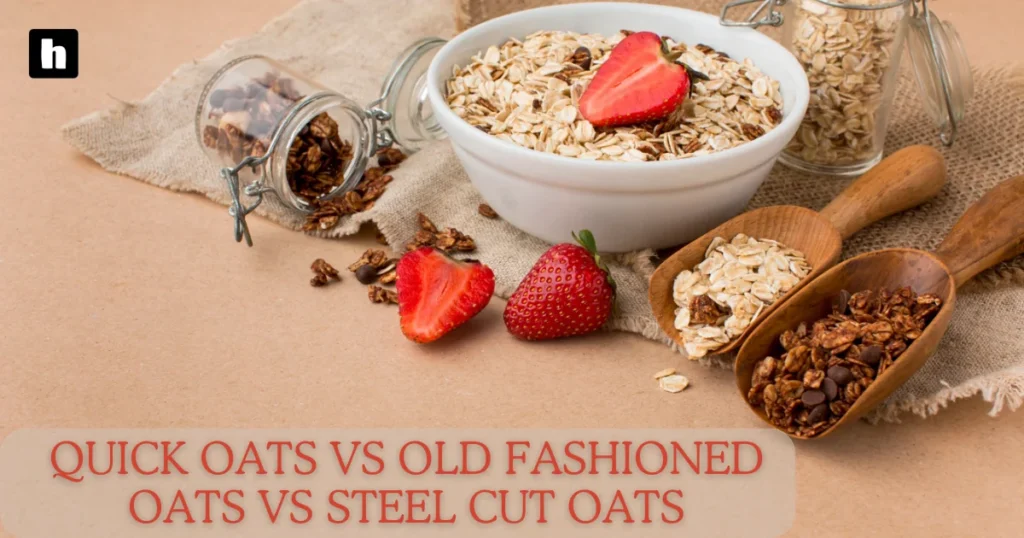
You might be wondering which type of oats—quick, old-fashioned, or steel-cut—is superior if you’re looking to improve the quality of your breakfast. What distinguishes these different kinds of oatmeal? Which one is the best to eat?
Processing and Production of Oatmeal
Oatmeal production commences with the initial step of cleaning and hulling oats to separate the husk from the oat groat. Subsequently, the groats are either cut or rolled to produce a range of oat varieties, including steel-cut or old-fashioned oats. Toasting, if desired, can be applied to enhance the flavor, particularly in the case of steel-cut oats. For faster preparation, instant oats undergo pre-cooking and drying. Finally, the oats are packaged in different forms, such as instant packets or old-fashioned oats, to cater to the preferences of oatmeal enthusiasts. Throughout the entire process, the utmost care is taken to preserve the nutritional value while offering convenient and diverse options for consumers.
Related: 7 Health Benefits of Eating Oats and Oatmeal
Steel Cut Oats
Steel-cut oats closely resemble the oat groat in terms of visual appearance. These oats are simply cut into two or three pieces, resulting in a larger and less processed final product. Due to their size and minimal processing, steel-cut oats require the longest cooking time of approximately 20 minutes when prepared by the consumer.
Quick Oats
To create quick oats, groats are first chopped into smaller pieces, then steamed, processed through rollers, and lightly toasted. This production process closely resembles that of old-fashioned oats, but the quick oats are smaller in size, allowing for a faster cooking time. In just about one minute, quick oats can be fully cooked and ready to enjoy.
Old Fashioned Oats
Rolled oats, also known as old fashioned oats, are processed in a specific manner. This involves steaming the oats and passing them through rollers to flatten the groat. The grain is then lightly toasted to stabilize it. Due to their smaller size and steaming process, rolled oats cook faster than steel-cut oats, taking only about five minutes.
Considerations for Quick Oats vs. Old Fashioned Oats vs. Steel Cut Oats
Cooking Time:
1. Quick Oats: With the fastest cooking time, Quick Oats are perfect for those who need a quick and convenient breakfast option.
2. Old Fashioned Oats: Old Fashioned Oats have a moderate cooking time, slightly longer than Quick Oats, but are still a great choice for a speedy breakfast.
3. Steel-cut oats: Known for their hearty texture, steel-cut oats have the longest cooking time. They require a bit more patience, but they are worth the wait.
Texture:
1. Quick Oats: Quick Oats have a smooth and finer texture, making them ideal for those who prefer a smoother consistency in their oatmeal.
2. Old-fashioned oats: Compared to quick oats, old-fashioned oats have a chewier texture. They provide a bit more substance and a satisfying bite.
3. Steel-cut oats: With a coarser and nuttier texture, steel-cut oats offer a hearty bite. They are perfect for those who enjoy a more substantial and textured oatmeal.
Nutritional Content:
- All three types of oats offer similar nutritional benefits, making them a healthy choice for breakfast.
- However, the processing levels of oats may impact the glycemic index, so it’s important to consider this factor when choosing your oats.
Versatility:
1. Quick Oats: Quick oats are great for baking and recipes that require a finer texture. They can be used in a variety of dishes, adding a smooth and creamy element.
2. Old Fashioned Oats: Old Fashioned Oats are versatile and can be used in various recipes and breakfast options. They provide a chewier texture and can be customized to suit different preferences.
3. Steel Cut Oats: Preferred for a wholesome and filling breakfast bowl, Steel Cut Oats are perfect for those who enjoy a heartier and more textured oatmeal.
Preference and Convenience:
1. Quick Oats: Quick oats are the most convenient option for those with time constraints. They can be prepared quickly, allowing you to enjoy a nutritious breakfast even on busy mornings.
2. Old Fashioned Oats: Old Fashioned Oats offer a balanced option suitable for various preferences. They provide a satisfying texture and can be customized with different toppings and flavors.
3. Steel-cut oats: Favored by those who value a heartier and textured oatmeal, steel-cut oats are perfect for those who want a more substantial and filling breakfast. They may require more time to cook, but they are worth the extra effort.
Which one is nutrient-richer?
It can be challenging to choose the healthiest oat due to the wide variety available on the market.
The nutritional differences between a 1.4-ounce (oz) or 40-g serving of rolled, steel-cut, and quick oats are shown in the chart below (1, 2, 3):
| Nutrients | Rolled oats | Steel-cut oats | Quick oats |
|---|---|---|---|
| Calories | 150 | 150 | 150 |
| Carbs | 27 g | 27 g | 27 g |
| Protein | 5 g | 5 g | 5 g |
| Fat | 3 g | 2.5 g | 3 g |
| Fiber | 4 g | 4 g | 4 g |
| Sugar | 0 g | 1 g | 1 g |
These three oat varieties differ slightly from one another, as you can see. Still, there might be some differences between quick, rolled, and steel-cut oats.
Quick oats have a higher glycemic index
Steel-cut and rolled oats are known to possess a lower glycemic index compared to quick oats.
Foods low on the glycemic index release energy more slowly and can help stabilize blood sugar, whereas foods high on the index cause blood sugar to spike more quickly.
Rolling or steel-cut oats may therefore be the best option to promote improved blood sugar regulation.
Still, if you want to support blood sugar control, you can also include quick oats in a balanced diet by topping them with high-protein or high-fat foods like nuts or seeds.
Are rolled oats better than quick oats?
All oats originate from the same groat; however, as you are aware, the various types of oats are a consequence of varying degrees of processing. Did you experience a momentary reaction when I mentioned the term “processing”? Let us delve into that matter!
Despite the claims made by marketing, it is important to note that the term “processed food” does not necessarily imply that a food is unhealthy. According to the USDA’s definition (4), processed food refers to any raw agricultural commodity that has undergone various procedures such as washing, cleaning, milling, cutting, chopping, heating, pasteurizing, blanching, cooking, canning, freezing, drying, dehydrating, mixing, packaging, or other alterations that deviate it from its natural state.
Additionally, the definition of “processed food” is broad. This spectrum is broken down in this article from the Academy of Nutrition & Dietetics (5), which goes from minimally processed (meaning a food has been chopped, bagged, etc. for convenience) to heavily processed (meaning a food has been cooked, altered to add flavors and textures, etc.). Consider that whole freezer meals, for example, are more heavily processed than oats, which are more of that minimally processed food.
Fortunately, oats of all kinds offer many of the same health advantages and are all categorized as whole grains. Steel-cut oats take longer to digest because they are less processed and typically contain more fiber.
It is also mentioned that steel cut might have a lower glycemic index because of the additional fiber and less processing. To be honest, when it comes to choosing which oat to buy, go for the one you enjoy the texture of the most, think would work best in your recipe, or just happen to be your favorite. Taste and texture (6) are the main factors that distinguish steel-cut oats from quick oats and rolled oats. Here, avoid overcomplication and getting lost in the details.
How to Choose the Right Oats
For instance, steel-cut oats are known for their chewy texture and nutty flavor, which may be highly enjoyable for some individuals but might be too filling for others.
On the other hand, rolled oats have a more subtle taste, and when cooked, they result in a creamy and smooth consistency. This can be particularly appealing to those who prefer a smoother texture in their oatmeal.
Quick and rolled oats, on the other hand, cook to a creamy, smooth consistency and have a softer flavor.
Furthermore, the minimal processing of steel-cut oats means that they require the longest preparation time, which may turn off some people.
You can cut back on added sugar in your diet by opting for unsweetened, plain oats rather than flavored, packaged varieties, regardless of the type of oats you choose.
Many diseases, such as diabetes, obesity, and heart disease, can be caused by a lot of added sugar (7).
To minimize the amount of added sugar, it is advisable to include your own toppings, like fresh fruit, nuts, or seeds, when consuming unsweetened oats.
Oats: Baking and Alternative Uses
Quick-cooking oats and regular rolled oats can usually be used interchangeably in baking recipes. If you only have old-fashioned rolled oats and your recipe calls for quick-cooking oats, pulse the old-fashioned oats in the food processor a few times. The texture will differ if quick-cooking oats are substituted for traditional rolled oats in a recipe, but most recipes won’t really care about that.
Oats can also be transformed into oat flour or ground oats. The process simply requires a blender or food processor to create finely ground oat flour. This gluten-free alternative can effectively substitute regular flour in various recipes.
How to use oats in your diet
Oats are typically eaten for breakfast, but they can also be a nutritious option for lunch and dinner.
Here are some suggestions for incorporating oats into your daily routine:
- Add raw oats to your smoothie for a fiber boost.
- Instead of using breadcrumbs to coat fish or chicken, use them.
- Add oats to the pancake batter.
- When preparing risotto, use them instead of rice.
- They add a creamy texture to soups without adding a lot of fat.
The bottom line
Oats, a grain high in fiber, have been linked to several health advantages.
Quick oats and rolled and steel-cut oats have similar nutritional profiles, despite the latter’s lower glycemic index.
It’s a good idea to choose plain, unsweetened oat varieties whenever possible, though, as packaged instant varieties sometimes have a lot of added sugar.
Frequently Asked Questions
1. What is the difference between Quick Oats vs Old Fashioned Oats vs Steel Cut Oats?
Quick oats are smaller and cook faster, while old-fashioned oats are rolled and have a chewier texture. Steel-cut oats are the least processed, offering a heartier bite.
2. Which oats are best for baking and have alternative uses?
Quick oats work well for finer textures in baking, while old-fashioned oats and steel-cut oats offer versatility in various recipes, providing options for different preferences.
3. How do I choose the right oats for my preferences?
Consider factors like texture, flavor, and cooking time. Steel-cut oats are heartier, old-fashioned oats have a balanced appeal, and quick oats are the most convenient for those with time constraints.
4. How can oats be used in alternative ways?
Oats can be transformed into flour for gluten-free alternatives, added to smoothies, used as a coating for fish or chicken, incorporated into pancake batter, or substituted for rice in risotto.


